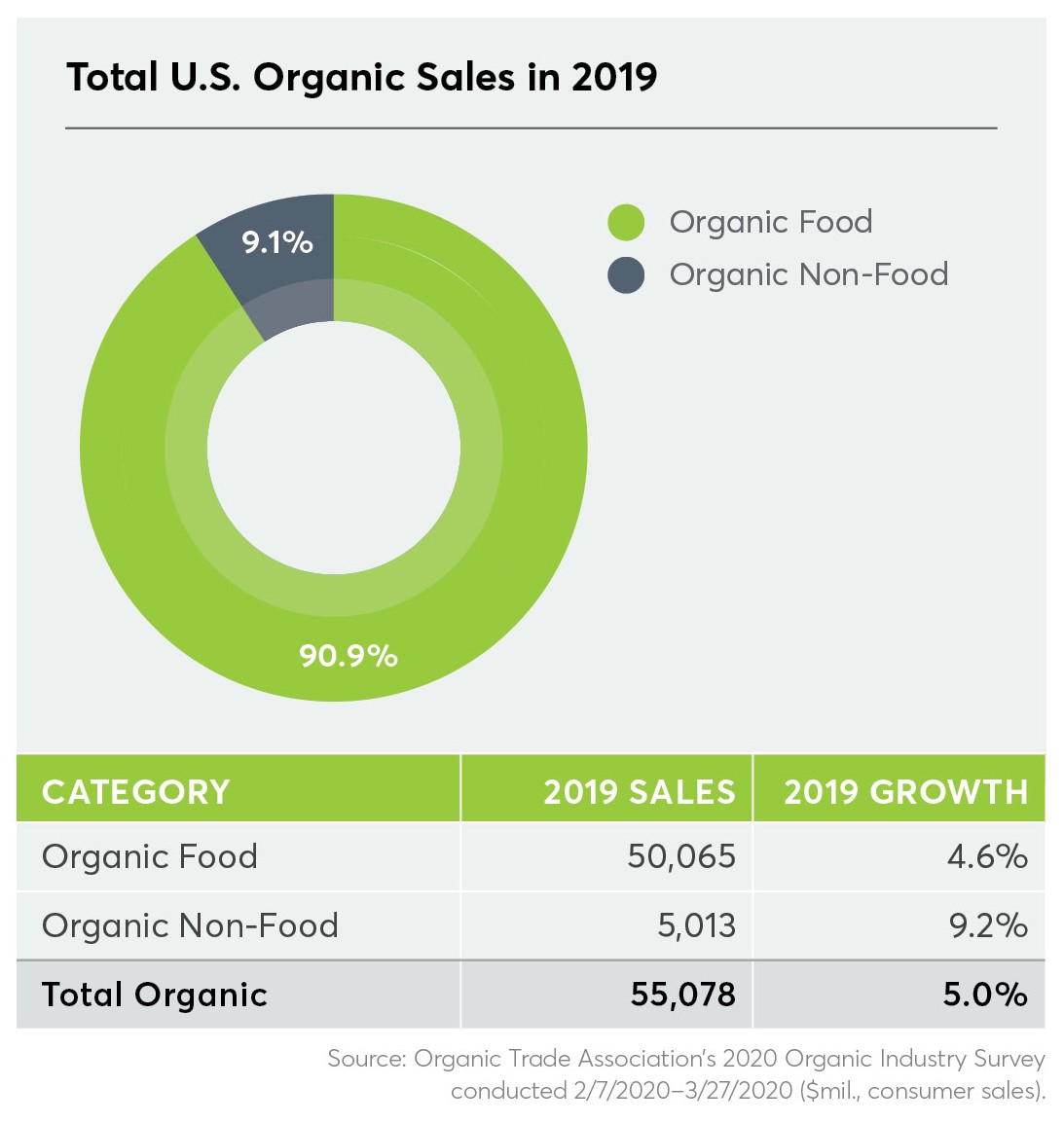Importance of organic continues to rise, as sales hit $55.1 billion in 2019, says Organic Trade Association
The unprecedented COVID-19 pandemic this year -- and its enormous impact on our everyday lives – has already had dramatic consequences for the organic sector in 2020. As shoppers search for healthy, clean food to feed their at-home families, organic food is proving to be the food of choice for home.
Never before has the food we provide our families been more important, and consumers have turned to the trusted Organic label. Many solid-growth organic categories have seen demand exploding. Organic produce sales for one, after jumping by more than 50 percent in the early days of kitchen stocking, were up more than 20 percent in the spring of 2020. Other categories experiencing softer growth have been seeing big boosts in demand: the run on groceries meant organic milk was in high demand, for example, and sales of organic eggs skyrocketed. Packaged and frozen organic foods saw double-digit growth as consumers upped at-home meal preparation.
Today’s interest in organic may be intensified, but organic’s growing popularity isn’t new. Consumers are eating more organic food and using more organic products than ever before, according to the 2020 Organic Industry Survey released Tuesday by the Organic Trade Association. The U.S. organic sector posted a banner year in 2019, with organic sales in the food and non-food markets totaling a record $55.1 billion, up a solid 5 percent from the previous year.
 Both the food and non-food markets shattered major benchmarks. Organic food sales hit $50.1 billion, up 4.6 percent. Organic non-food sales totaled just over $5 billion, up a strong 9.2 percent. Both sectors easily outpaced the general market growth rate of around 2 percent for total food sales and of just 3 percent for total non-food sales.
Both the food and non-food markets shattered major benchmarks. Organic food sales hit $50.1 billion, up 4.6 percent. Organic non-food sales totaled just over $5 billion, up a strong 9.2 percent. Both sectors easily outpaced the general market growth rate of around 2 percent for total food sales and of just 3 percent for total non-food sales.
“Our 2020 survey looks at organic sales in 2019 before the coronavirus outbreak, and it shows that consumers were increasingly seeking out the Organic label to feed their families the healthiest food possible. The pandemic has only increased our desire for clean, healthy food,” said Laura Batcha, CEO and Executive Director of the Organic Trade Association. “Our normal lives have been brought to a screeching halt by the coronavirus. The commitment to the Organic label has always resided at the intersection of health and safety, and we expect that commitment to strengthen as we all get through these unsettled times.”
In the early stages of the COVID-19 outbreak, the Organic Trade Association undertook a multi-pronged effort to look not only at shifting patterns in organic shopping since the crisis began, but to gather intelligence on the overall retail landscape for organic, and on the organic supply chain: where the supply chain is holding together and where it is being challenged. The association worked with Mercaris Data Service and Category Partners strategic insights company to put together the latest insights and outlooks for the organic sector.

The association also conducted an online flash poll of 3,188 “likely organic” shoppers in late April and early May. More than 90 percent of respondents indicated that in their current food shopping, organic is more important than ever.
For more information on COVID-19 impacts, see the webinar presented by the trade association in May on organic’s shifting retail landscape as a result of the coronavirus.
The way it was in 2019
- Organic produce maintains top position.
Say organic to food shoppers and the first things many of us think of are organic apples and strawberries, organic carrots and lettuce. In other words, produce. Organic generally still matters most to us when we’re shopping in the fresh produce aisles. Organic fruit and vegetable sales in 2019 were up nearly 5 percent, hitting $18 billion, as the category continues to be the star of the organic sector, and often the starting point for organic food buying. Millennials and younger generations have grown up with organic, and remain the growth drivers for this category. Organic produce makes up almost a third of all organic food sales, and organic fruits and vegetables, including fresh, frozen, canned, and dried, have now captured 15 percent of the fruits and vegetables market in this country.
- Organic dairy working its way out of oversupply; meat and poultry showing robust growth.
In 2019, growth remained low for organic dairy, but late in the year, the category slowly started to move away from the period of oversupply of skim milk and not enough butterfat that hampered growth in 2017 and 2018. Overall, the $6.6 billion category grew at a rate of almost 2 percent. Organic dairy is holding its own, and growing faster than the conventional market, with the overall dairy category growing only 0.2 percent. Organic dairy & eggs accounted for just over 8 percent of the total dairy and eggs market. Organic meat, poultry, and fish remained the smallest organic food category in 2019, with $1.4 billion in sales, but the segment also saw almost 10 percent growth, the highest growth of any organic food category. Organic poultry remained the organic protein of choice, and the $865 million poultry market made up more than half of the sales for the organic meat, poultry and seafood category.
- Spicing up home cooking with organic condiments.
What to have with your organic meat? Organic ketchup, of course, or maybe organic chipotle or curry sauce for the more adventurous. Although it is the second smallest organic food category, the products in the organic condiment category saw some of the biggest growth. Sales of organic ethnic sauces – curry, chipotle, sriracha, Korean BBQ – reached $77 million for the strongest growth rate ever of more than 23 percent. Organic ketchup sales also spiked in 2019 to $57 million, up almost 16 percent, thanks to healthier versions of this classic condiment, including sugar-free and low sugar offerings. Organic spices recorded $345 million in sales with more than 15 percent growth.
- Outside the organic food tent, good growth in the non-food market.
The organic non-food market crossed the $5 billion mark in 2019 for the first time, with strong growth of 9.2 percent. It now accounts for just over 9 percent of total organic sales. Growing concerns about toxins and chemicals not just in our bodies, but also on our skin, in our homes, and in our environment, along with wider availability of products, have created a robust market for the organic non-food sector. Fiber sales – sales of clothing, bedding, mattresses -- continued to lead the sector, and crossed the $2 billion mark in 2019, up just over 12 percent. Organic dietary supplements also were a standout, with sales up just over 10 percent to a record $1.7 billion.
This year’s survey was conducted early in 2020 from February 7 through March 27 and produced on behalf of the Organic Trade Association by Nutrition Business Journal (NBJ). Nearly 200 companies completed a significant portion of the in-depth survey. Executive summaries of the survey are available to the media upon request. The full report can be purchased; online orders can be placed on this page.
What’s ahead?
 While there were certain growth trajectories taking shape going into 2020, the onset of COVID-19 turned the organic food marketplace upside down early in the year. Prior to 2020, the organic market has been growing steadily year over year. The U.S. economy has been battered by the pandemic, and experts say there are a few ways that could play out for organic. Because people are price sensitive, there could be a slowdown in the growth of organic sales. Or, because people are increasingly aware of their health and looking for cleaner products, they may be willing to invest in premium products.
While there were certain growth trajectories taking shape going into 2020, the onset of COVID-19 turned the organic food marketplace upside down early in the year. Prior to 2020, the organic market has been growing steadily year over year. The U.S. economy has been battered by the pandemic, and experts say there are a few ways that could play out for organic. Because people are price sensitive, there could be a slowdown in the growth of organic sales. Or, because people are increasingly aware of their health and looking for cleaner products, they may be willing to invest in premium products.
Influenced by COVID, all of the staples categories, from dairy and eggs, to breads, pastas, rice and grains and baking supplies, such as flour and baking yeast, are expected to see increased growth in 2020, provided supply can meet demand. In the non-food organic market, organic vitamins and immunity-related products are expected to see strong growth, as are organic supplements and household products.
“It’s hard to know what’s ahead of us, but consumers will continue to trust in and depend on the Organic label,” said the Organic Trade Association’s Batcha. “Organic producers and processors – indeed the entire organic supply chain – have been working around the clock through this difficult time to keep our stores filled with healthy, toxic-free and sustainably produced organic food and products. Organic is going to be there for the consumer.”
The Organic Trade Association (OTA) is the membership-based business association for organic agriculture and products in North America. OTA is the leading voice for the organic trade in the United States, representing over 9,500 organic businesses across 50 states. Its members include growers, shippers, processors, certifiers, farmers' associations, distributors, importers, exporters, consultants, retailers and others. OTA’s Board of Directors is democratically elected by its members. OTA's mission is to promote and protect ORGANIC with a unifying voice that serves and engages its diverse members from farm to marketplace. The Organic Trade Association does not discriminate on the basis of age, disability, national origin or ancestry, race, gender, religion, sexual orientation, marital status, political affiliation or military status. Persons with disabilities who require alternate means for communication of program information can contact us at info@ota.com.
